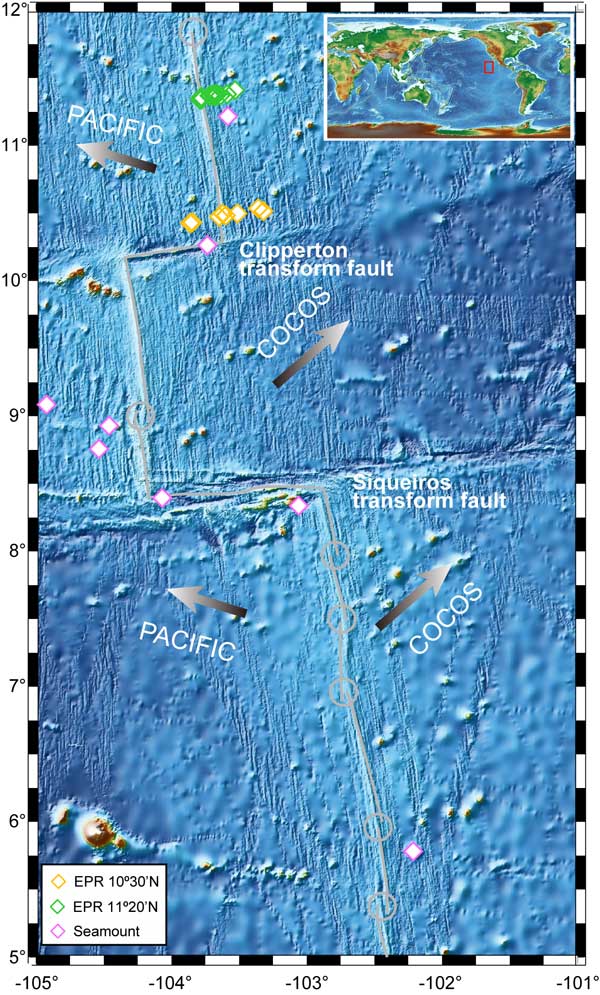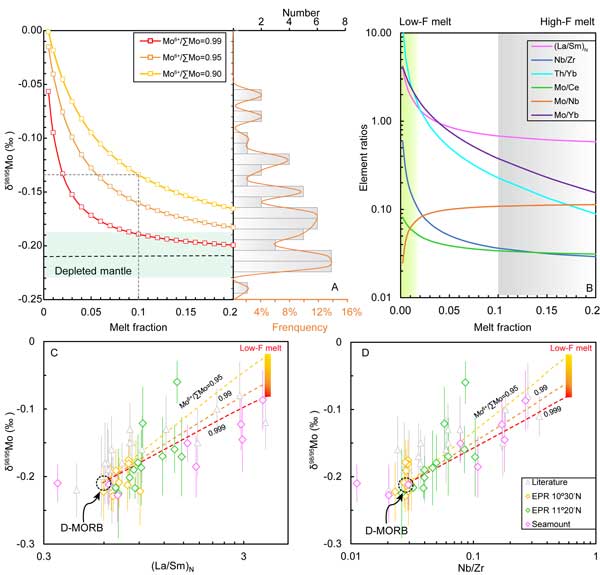|
Shuo Chen1,2, Pu Sun1,2, Yaoling Niu2,3,4, Pengyuan Guo1,2, Tim Elliott5, Remco C. Hin6
1Key Laboratory of Marine Geology and Environment, Institute of Oceanology, Chinese Academy of Sciences, Qingdao 266071, China; shuochen@qdio.ac.cn ; pu.sun@qdio.ac.cn; guopy@qdio.ac.cn
2Laboratory for Marine Geology, Pilot National Laboratory for Marine Science and Technology, Qingdao 266061, China
3Department of Earth Sciences, Durham University, Durham DH1 3LE, UK; yaoling.niu@durham.ac.uk
4China University of Geosciences, Beijing 100083, China
5Bristol Isotope Group, School of Earth Sciences, University of Bristol, Bristol BS8 1RJ, UK; Tim.Elliott@bristol.ac.uk
6Bayerisches Geoinstitut, Universität Bayreuth, Bayreuth 95447, Germany; Remco.Hin@uni-bayreuth.de
This webpage is a summary of: Chen, S., Sun, P., Niu, Y., Guo, P., Elliott, T. and Hin, R.C., 2022. Molybdenum isotope systematics of lavas from the East Pacific Rise: Constraints on the source of enriched mid-ocean ridge basalt. Earth Planet. Sci. Lett., 578: 117283.
Summary
Studies of mid-ocean ridge basalts (MORB) and near-ridge seamounts have shown large sub-ridge mantle compositional heterogeneity on various scales. However, their origin has been highly debated, with interpretations including addition to the source region of recycled crustal materials, mantle wedge materials and low-degree melt metasomatism (Allègre & Turcotte, 1986; Donnelly et al., 2004; Hofmann, 1997; Niu et al., 2002; Stracke, 2012). A growing body of recent literature has shown that a combination of stable Mo isotopes and radiogenic isotopes have great potential for studying mantle heterogeneities, especially those caused by subduction-related processes. For instance, it has been suggested that ocean crust passing through subduction zones should acquire isotopically light Mo and carry this distinctive signature into the mantle (Freymuth et al., 2015; Chen et al., 2019). If subducted ocean crust is important in enriching portions of the convecting upper mantle, producing enriched MORB (E-MORB), then these melts would be expected to inherit such an isotopically light Mo signature.
The current Mo isotope database for MORB is very small and the possible effects of magma generation and evolution on Mo isotopes remain debated (Bezard et al., 2016; Liang et al., 2017). A more comprehensive study of the Mo isotopic compositions of variably enriched MORB is therefore required to resolve the debate and to use this novel isotope as an effective tracer for the origin of upper mantle enrichment.
Here we presented a comprehensive study of the Mo isotopic compositions on well-characterized MORB samples. These were obtained on and off-axis across morphologically typical ridge segments of the East Pacific Rise (EPR) and from seamount lavas on the flanks of the EPR between 5°N and 12°N (Figure 1). Samples from the EPR at 10º30’N are normal, depleted MORB, derived from a compositionally uniform source in terms of radiogenic isotopes, but they have a wide compositional range in MgO (1.8–7.4 wt.%) with well-defined liquid lines of descent (LLD) (Regelous et al., 1999). In contrast, the EPR at 11º20’N is marked by an anomalously large numbers of enriched MORB samples (Niu et al., 1999). The seamount lavas are more diverse in composition than axial MORB, varying from highly enriched alkali basalts to extremely depleted tholeiites (Niu et al., 2002).

Figure 1: Simplified map of the EPR between 5º and 12ºN and samples investigated for Mo isotopes in this study. Base map generated using GMT software.
Our analyses show significant Mo isotope variations with δ98/95Mo (relative to NIST SRM3134) ranging from -0.23‰ to -0.06‰. We argue that these Mo isotope variations are not caused by processes of MORB melt generation and evolution but reflect mantle isotopic heterogeneity. Taking together with data from the literature, we show that MORB Mo isotope compositions vary systematically with geochemical parameters indicating mantle enrichment (Figure 2). These observations are best explained by two-component mixing between an incompatible element depleted endmember (e.g., low La/Sm, Nb/La, Nb/Zr and Th/Yb, but high Sm/Nd and 143Nd/144Nd) with low δ98/95Mo (~-0.21‰) and an incompatible element enriched endmember (e.g., high La/Sm, Nb/La, Nb/Zr and Th/Yb, but low Sm/Nd and 143Nd/144Nd) with high δ98/95Mo (~-0.05‰). Therefore, our new Mo isotope data from EPR MORB and seamount samples require incorporation of a recycled, enriched component with isotopically heavier Mo into the ambient depleted MORB mantle (DMM).
Recycled oceanic crust (ROC) has been considered a candidate for mantle enrichment for a long time (e.g., Allègre & Turcotte, 1986; Rehkämper & Hofmann, 1997). The Mo systematics presented here can provide a novel diagnostic tool for assessing the ROC model. Recycled, mafic oceanic crust should have low Mo/Ce ratio (lower than 0.03) as it loses much Mo during subduction (Chen et al., 2019; Freymuth et al., 2015). Thus, it cannot explain the elevated Mo/Ce ratios of E-MORB. More importantly, the dehydrated residues of subducted ocean crust (as eclogite) are further argued to be isotopically light in Mo (<−0.20‰) (Chen et al., 2019), in sharp contrast to the heavy Mo isotope characteristics of the E-MORB. Recycled sediments or continental crustal materials are in general strongly enriched in large ion lithosphile elements (LILE) but depleted in Nb and Ta relative to elements of similar compatibility, and thus cannot explain the elevated Ce/Pb, Nb/U and Nb/La ratios in EPR E-MORBs in our study. In this way we rule out the prevailing model of recycled ocean crust with or without sediment for the origin of Mo isotope variation in our samples, in support of the conclusions based on elemental and “traditional” radiogenic isotopes (Niu et al., 2002).
Based on our new data and modelling (Figure 2), we suggest that the enriched endmember is most consistent with localized, low-degree melt enrichment (metasomatism) within the depleted MORB mantle, most likely at the lithosphere-asthenosphere boundary (LAB), at some time in Earth’s history. We thus confirm that recycled oceanic mantle lithosphere, metasomatized by low degree melt, plays a key role in the formation of E-MORB source lithologies (Niu & O’Hara, 2003). In addition, we highlight the potential of Mo isotopes for providing an effective tool to study upper mantle processes.

Figure 2: Non-modal batch melting modelling of both incompatible trace element ratios and Mo isotope composition of melt. Click here or on image for enlargement.
References
-
Allègre, C.J., Turcotte, D.L., 1986. Implications of a two-component marble-cake mantle. Nature 323, 123-127.
-
Bezard, R., Fischer-Gödde, M., Hamelin, C., Brennecka, G.A., Kleine, T., 2016. The effects of magmatic processes and crustal recycling on the molybdenum stable isotopic composition of Mid-Ocean Ridge Basalts. Earth Planet. Sci. Lett. 453, 171-181.
-
Chen, S., Hin, R., John, T., Brooker, R., Bryan, B., Niu, Y., Elliott, T. 2019. Molybdenum systematics of subducted crust record reactive fluid flow from underlying slab serpentine dehydration. Nature Communications, 10, 4773.
-
Donnelly, K.E., Goldstein, S.L., Langmuir, C.H., Spiegelman, M., 2004. Origin of enriched ocean ridge basalts and implications for mantle dynamics. Earth Planet. Sci. Lett. 226, 347-366.
-
Freymuth, H., Vils, F., Willbold, M., Taylor, R.N., Elliott, T., 2015. Molybdenum mobility and isotopic fractionation during subduction at the Mariana arc. Earth Planet. Sci. Lett. 432, 176-186.
-
Hofmann, A.W., 1997. Mantle geochemistry: the message from oceanic volcanism. Nature 385, 219.
-
Liang, Y.-H., Halliday, A.N., Siebert, C., Fitton, J.G., Burton, K.W., Wang, K.-L., Harvey, J., 2017. Molybdenum isotope fractionation in the mantle. Geochim. Cosmochim. Acta 199, 91-111.
-
Niu, Y., Collerson, K.D., Batiza, R., Wendt, J.I., Regelous, M., 1999. Origin of enriched-type mid-ocean ridge basalt at ridges far from mantle plumes: The East Pacific Rise at 11 20′ J. Geophys. Res. Solid Earth 104, 7067-7087.
-
Niu, Y., Regelous, M., Wendt, I.J., Batiza, R., O’Hara, M.J., 2002. Geochemistry of near-EPR seamounts: importance of source vs. process and the origin of enriched mantle component. Earth Planet. Sci. Lett. 199, 327-345.
-
-
Regelous, M., Niu, Y., Wendt, J., Batiza, R., Grieg, A., Collerson, K., 1999. Variations in the geochemistry of magmatism on the East Pacific Rise at 10º300N since 800 ka. Earth Planet. Sci. Lett. 168, 45-63.
-
last updated 26th April, 2022 |
